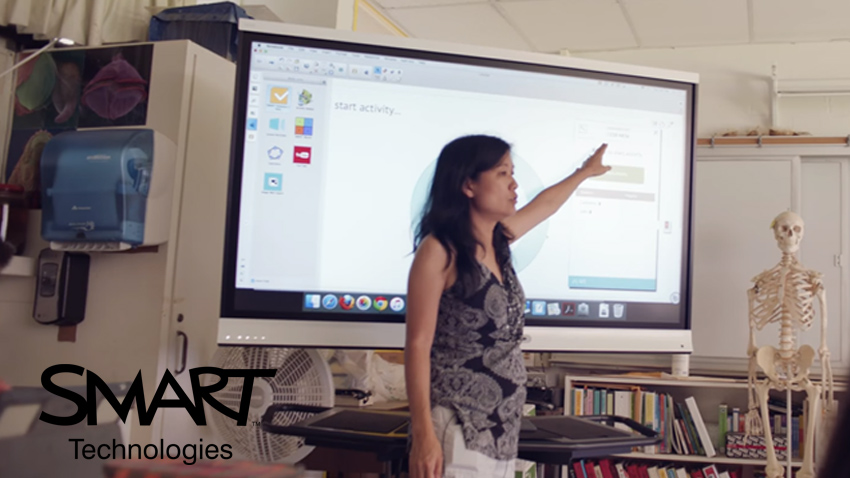SMART Technologies Inc. a leading provider of education and collaboration solutions, today reveals the findings of an international research study of teachers, education administrators and IT professionals in education that shows that large interactive displays are critical to the modern classroom environment.
- SMART Technologies announces international study highlighting the importance of technology, group pedagogy, and software in learning
- Research reveals over 400 responses from 26 countries across the World(i)
- Attainment levels, especially in Maths and English, increase by up to 34%, with an average improvement of 16%
SMART Technologies, in collaboration and consultation with a number of IT and education thought leaders and researchers, assessed the best practices and impacts of technology on active learning programs. The resulting study, launched this week, represents more than 400 educators, technology specialists, administrators and IT professionals.
SMART researchers collected data from over 26 countries(ii) and the research findings demonstrate that the increased use of mobile and display technology is strongly related to software and pedagogy, specifically the frequency of group activity vs. individual activity.
Increased use of technology, group pedagogy, and software are strongly related to student success, with attainment, especially in Maths and English, increasing by up to 34%, with an average improvement of 16%.
Jane Ashworth, UK MD of SMART Technologies, says: “Our research clearly demonstrates that many elements are necessary for a classroom ecosystem’s health and effectiveness. These include technology elements such as mobile devices, education and management software, large interactive displays, sound, networking and cloud technologies.
“Large interactive displays are clearly vital to the classroom ecosystem, and remain pivotal in effective group and whole class pedagogy and student driven learning.”
“As we continue to drive education towards usable lifetime skills and preparing students for viable futures in a technology based society, group learning, collaboration, and the more social aspects of education are gaining importance and are beginning to be measured in some geographies(iii)”

Along with the increase in group pedagogy, key software use increases with the frequency of mobile/display technology use. For example, frequent use of class collaborative software was reported in 24% of classrooms with low levels of use of both mobile and displays.
For classrooms with high levels of both, class collaboration software was frequently used 72% of the time. Use of student collaboration software, class collaboration software, game based software, and content creation software all positively and significantly relate to group activity.

Multiple observed measures of student success all relate positively to group activity. The above chart reveals the relationship between group activity and success measures. All are significant at the .100 level. The three strongest changes are in social and emotional learning (SEL) skills (an increase of 37%), participation (59%) and interdependence (55%). Group activity clearly matters in teaching the social oriented skills necessary in preparing students for the future. It is supported by a technology ecosystem with broad use of large scale interactive displays, mobile, software, and connectivity.
According to Dr. Kecia Ray, Executive Director of the Center for Digital Education, “Active Learning environments are critical to student success and the use of technology in these spaces amplifies the level of engagement we can expect to see.”
Jane Ashworth concludes: “Education is like a living ecosystem, a group of interconnected elements, formed by the interaction of a community of students, parents and teachers with their pedagogical and technological environment. The interconnected elements in the ecosystem are both interdependent and synergistic. Our research and the work of many others, support the notion that the whole is greater than the sum of its parts.”
“The research shows that many things are required to prepare students for the future. Technology deployments alone do not drive outstanding student results. The effective and healthy ecosystem involves professional development for teachers and media specialists, pedagogy and activity related content, ongoing support and the integration of individual and group technologies.
“It is clear that mobile and 1:1 are either here or about to be. Large scale interactive displays are also well-established in many environments. A trade-off of any of the parts of the ecosystem is likely to be ineffective. Maximum benefits accrue from the thoughtful integration of all of the elements.”
References:
(i)Teaching, technology and Learning, Filigree Consulting, sponsored by SMART Technologies, 2016
(ii)Teaching, technology and Learning, Filigree Consulting, sponsored by SMART Technologies, 2016
(iii)NMC Horizon Report 2015 K-12 Edition, Shift to Deeper Learning Approaches, New Media Consortium, https://www.nmc.org/publication/nmc-horizon-report-2015-k-12-edition/, 2015, p10
About SMART
SMART Technologies Inc. is a world leader in simple and intuitive classroom technology solutions. We are an innovator in software and interactive technologies that enable natural collaboration, helping every student and teacher discover and develop their greatness.
Research
Researchers segmented the sample by use of mobile devices (tablets and phones) and large scale interactive displays (interactive whiteboards, flat panels, and projection) into four groups:
- High use of both technology sets (29% of the sample). Generally daily/most lessons use
- Low of use both technologies (26%). Generally weekly or less frequent use
- High use of mobile and low use of interactive displays (21%)
- High use of interactive displays and low use of mobile (24%)







